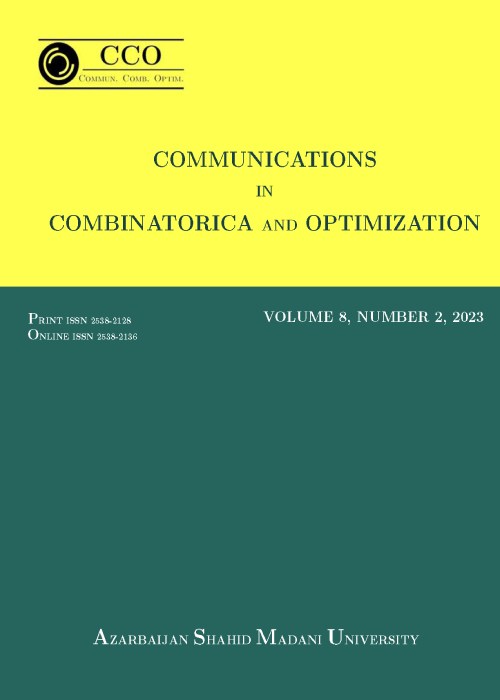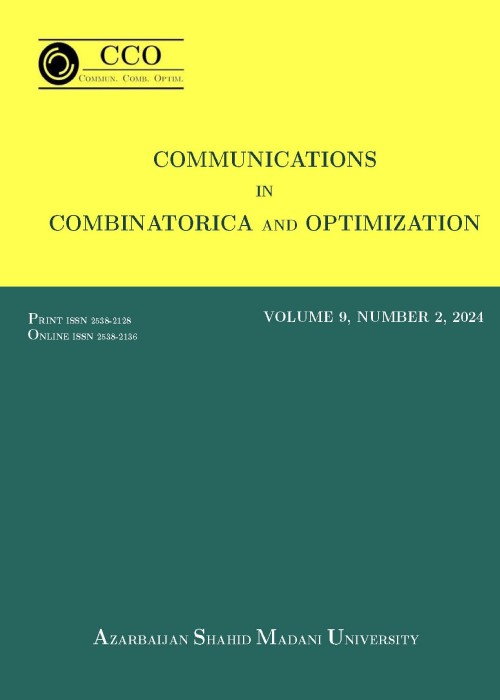فهرست مطالب

Communications in Combinatorics and Optimization
Volume:8 Issue: 2, Spring 2023
- تاریخ انتشار: 1402/03/04
- تعداد عناوین: 12
-
-
Pages 271-304A tractable method of solving 3-person games in which players’ pure strategies are staircase functions is suggested. The solution is meant to be Pareto-efficient. The method considers any 3-person staircase-function game as a succession of 3-person games in which strategies are constants. For a finite staircase-function game, each constant-strategy game is a trimatrix game whose size is likely to be relatively small to solve it in a reasonable time. It is proved that any staircase-function game has a single Pareto-efficient situation if every constant-strategy game has a single Pareto-efficient situation, and vice versa. Besides, it is proved that, whichever the staircase-function game continuity is, any Pareto-efficient situation of staircase function-strategies is a stack of successive Pareto-efficient situations in the constant-strategy games. If a staircase-function game has two or more Pareto-efficient situations, the best efficient situation is one which is the farthest from the triple of the most unprofitable payoffs. In terms of 0-1-standardization, the best efficient situation is the farthest from the triple of zero payoffs.Keywords: game theory, payoff functional, Pareto efficiency, staircase-function strategy, trimatrix game
-
Pages 305-311The Sombor index of the graph $G$ is a degree based topological index, defined as $SO = sum_{uv in mathbf E(G)}sqrt{d_u^2+d_v^2}$, where $d_u$ is the degree of the vertex $u$, and $mathbf E(G)$ is the edge set of $G$. Bounds on $SO$ are established in terms of graph energy, size of minimum vertex cover, matching number, and induced matching number.Keywords: Sombor index, degree (of vertex), graph
-
Pages 313-326In this paper we characterize the commutative rings with unity for which line signed graph of signed unit graph is balanced and consistent. To do this, first we derive some sufficient conditions for balance and consistency of signed unit graphs. The results have been demonstrated with ample number of examples.Keywords: finite commutative rings, Signed graph, unit graph
-
Pages 327-348In this paper, we have punctured unit $mathbb{Z}_q$-Simplex code and constructed a new code called unit $mathbb{Z}_q$-Simplex code of type $alpha$. In particular, we find the parameters of these codes and have proved that it is an $left[phi(q)+2, ~hspace{2pt} 2, ~hspace{2pt} phi(q)+2 - frac{phi(q)}{phi(p)}right]$ $mathbb{Z}_q$-linear code $text{if} ~ k=2$ and $left[frac{phi(q)^k-1}{phi(q)-1}+phi(q)^{k-2}, ~k,~ frac{phi(q)^k-1} {phi(q)-1}+phi(q)^{k-2}-left(frac{phi(q)}{phi(p)}right)left(frac{phi(q)^{k-1}-1}{phi(q)-1}+phi(q)^{k- 3}right)right]$ $mathbb{Z}_q$-linear code if $k geq 3, $ where $p$ is the smallest prime divisor of $q.$ For $q$ is a prime power and rank $k=3,$ we have given the weight distribution of unit $mathbb{Z}_q$-Simplex codes of type $alpha$. Also, we have introduced some new code from $mathbb{Z}_q$-Simplex code called zero divisor $mathbb{Z}_q$-Simplex code and proved that it is an $left[ frac{rho^k-1}{rho-1}, hspace{2pt} k, hspace{2pt} frac{rho^k-1}{rho-1}-left(frac{rho^{(k-1)}-1}{rho-1}right)left(frac{q}{p}right) right]$ $mathbb{Z}_{q}$-linear code, where $rho = q-phi(q)$ and $p$ is the smallest prime divisor of $q.$ Further, we obtain weight distribution of zero divisor $mathbb{Z}_q$-Simplex code for rank $k=3$ and $q$ is a prime power.Keywords: Unit Zq-Simplex codes of type α, Unit Zq-MacDonald code, Zero divisor Zq-Simplex code, Weight distribution
-
Pages 349-358Let $S = (G,sigma)$ be a signed graph. A function $f: V rightarrow {0,1,2}$ is a Roman dominating function on $S$ if $(i)$ for each $v in V,$ $f(N[v]) = f(v) + sum_{u in N(v)} sigma(uv ) f(u) geq 1$ and $(ii)$ for each vertex $ v $ with $ f(v) = 0 $ there exists a vertex $u in N^+(v)$ such that $f(u) = 2.$ In this paper we initiate a study on Roman dominating function on signed graphs. We characterise the signed paths, cycles and stars that admit a Roman dominating function.Keywords: domination, Dominating functions, Roman dominating functions
-
Pages 359-378Cop Robber game is a two player game played on an undirected graph. In this game, the cops try to capture a robber moving on the vertices of the graph. The cop number of a graph is the least number of cops needed to guarantee that the robber will be caught. We study textit{cop-edge critical} graphs, i.e. graphs $G$ such that for any edge $e$ in $E(G)$ either $c(G-e)< c(G)$ or $c(G-e)>c(G)$. In this article, we study the edge criticality of generalized Petersen graphs and Paley graphs.Keywords: Cops, Robbers, vertex-pursuit games, Petersen graphs, Paley graphs
-
Pages 379-390Let $mathscr{D}$ be a simple connected digraph with $n$ vertices and $m$ arcs and let $W(mathscr{D})=mathscr{D},w)$ be the weighted digraph corresponding to $mathscr{D}$, where the weights are taken from the set of non-zero real numbers. Let $nu_1,nu_2, dots,nu_n$ be the eigenvalues of the skew Laplacian weighted matrix $widetilde{SL}W(mathscr{D})$ of the weighted digraph $W(mathscr{D})$. In this paper, we discuss the skew Laplacian energy $widetilde{SLE}W(mathscr{D})$ of weighted digraphs and obtain the skew Laplacian energy of the weighted star $W(mathscr{K}_{1, n})$ for some fixed orientation to the weighted arcs. We obtain lower and upper bounds for $widetilde{SLE}W(mathscr{D})$ and show the existence of weighted digraphs attaining these bounds.Keywords: Weighted digraph, skew Laplacian matrix of weighted digraphs, skew Laplacian energy of weighted digraphs
-
Pages 391-396
For a (molecular) graph, the second Zagreb index $M_2(G)$ is equal to the sum of the products of the degrees of pairs of adjacent vertices. Roman dominating function $RDF$ of $G$ is a function $f:V(G)rightarrow {0,1,2}$ satisfying the condition that every vertex with label 0 is adjacent to a vertex with label 2. The weight of an $RDF$ $f$ is $w(f)=sum_{vin V(G)} f(v)$. The Roman domination number of $G$, denoted by $gamma_R (G)$, is the minimum weight among all RDF in $G$. In this paper, we present a lower bound on the second Zagreb index of trees with $n$ vertices and Roman domination number and thus settle one problem given in [On the Zagreb indices of graphs with given Roman domination number, Commun. Comb. Optim. DOI: 10.22049/CCO.2021.27439.1263 (article in press)].
Keywords: Second Zagreb index, Roman domination number, tree -
Pages 397-409The concept of topology defined on a set can be extended to the field of graph theory by defining the notion of graph topologies on graphs where we consider a collection of subgraphs of a graph $G$ in such a way that this collection satisfies the three conditions stated similarly to that of the three axioms of point-set topology. This paper discusses an introduction and basic concepts to the graph topology. A subgraph of $G$ is said to be open if it is in the graph topology $mathscr{T}_G$. The paper also introduces the concept of the closed graph and the closure of graph topology in graph topological space using the ideas of decomposition-complement and neighborhood-complement.Keywords: Graph topology, graph topological space, $sT$-interior, $sT$-neighbourhood
-
Pages 411-421The $2S3$ transformation, which was first described for positive integers, has been defined for dyadic rational numbers in the open interval $(0,1)$ in this study. The set of dyadic rational numbers is a Prüfer 2-group. For the dyadic $2S3$ transformation $T_{ds}(x)$, the restricted multiplicative and additive properties have been established. Graph parameters are used to generate more combinatorial outcomes for these properties. The relationship between the SM dyadic sum graph's automorphism group and the symmetric group has been investigated.Keywords: SM sum graphs, Bipartite Kneser type-1 graphs, Dyadic fractions, Dyadic 2S3 transformation function
-
Pages 423-430A coalition in a graph $G = (V, E)$ consists of two disjoint sets $V_1$ and $V_2$ of vertices, such that neither $V_1$ nor $V_2$ is a dominating set, but the union $V_1 cup V_2$ is a dominating set of $G$. A coalition partition in a graph $G$ of order $n = |V|$ is a vertex partition $pi = {V_1, V_2, ldots, V_k}$ such that every set $V_i$ either is a dominating set consisting of a single vertex of degree $n-1$, or is not a dominating set but forms a coalition with another set $V_j$. Associated with every coalition partition $pi$ of a graph $G$ is a graph called the coalition graph of $G$ with respect to $pi$, denoted $CG(G,pi)$, the vertices of which correspond one-to-one with the sets $V_1, V_2, ldots, V_k$ of $pi$ and two vertices are adjacent in $CG(G,pi)$ if and only if their corresponding sets in $pi$ form a coalition. In this paper, we initiate the study of coalition graphs and we show that every graph is a coalition graph.Keywords: dominating set, Coalition, independent dominating set
-
Pages 431-444Let $G=(V,E)$ be a simple graph with vertex set $V$ and edge set $E$. An {outer-independent total $2$-rainbow dominating function of a graph $G$ is a function $f$ from $V(G)$ to the set of all subsets of ${1,2}$ such that the following conditions hold: (i) for any vertex $v$ with $f(v)=emptyset$ we have $bigcup_{uin N_G(v)} f(u)={1,2}$, (ii) the set of all vertices $vin V(G)$ with $f(v)=emptyset$ is independent and (iii) ${vmid f(v)neqemptyset}$ has no isolated vertex. The outer-independent total $2$-rainbow domination number of $G$, denoted by ${gamma}_{oitr2}(G)$, is the minimum value of $omega(f)=sum_{vin V(G)} |f(v)|$ over all such functions $f$. In this paper, we study the outer-independent total $2$-rainbow domination number of $G$ and classify all graphs with outer-independent total $2$-ainbow domination number belonging to the set ${2,3,n}$. Among other results, we present some sharp bounds concerning the invariant.Keywords: Domination number, $2$-rainbow domination number, total $2$-rainbow domination number, outer-independent total $2$-rainbow domination number


